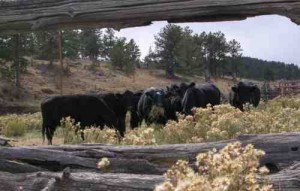Review by Lynda La Rocca
Literature – January 2008 – Colorado Central Magazine
I have sung the praises of Gregory Maguire before (for proof, see the December 2004 issue of Colorado Central), and now I’m at it again. The author of Wicked: The Life and Times of the Wicked Witch of the West revisits Oz in Son of a Witch, another enchanting, wildly imaginative fable that, like its predecessor, employs humor, drama, horror, and scathing political satire to examine the nature of good and evil.
Elphaba, the Wicked Witch of the West, remains a major presence in this sequel, but only as a memory. The victim of Dorothy (who killed Elphaba at the behest of the Hitler-like Wizard in what she now rationalizes as “an accident” ), the Witch has left her cape and broom to Liir, who may or may not be her son. Liir uncovers his past and finds his future through a series of adventures, escapes, and losses connected to his search for the missing Nor, who may be his half-sister. In the process, he encounters Animals, that race of sentient beings who are still being as viciously pursued and targeted for Nazi-style extermination as they were in Wicked, and is nearly killed by a flight of dragons. Bred as weapons of war, these beasts spread terror by both killing and mutilating their victims.
Maguire loves playing with language and inventing words that are at once bizarre yet appropriate. The people of Oz celebrate Treason Night and adhere to Lurlinism, a discredited faith named after the goddess Lurlina who “wooed Oz into being.” They play sports like gooseball and musical instruments called domingons. They eat aged skark cheese, dried garmot, pearlfruit, and mutton with a side of tadmuck. And they talk with Animals like the Red Pfenix and the Mountain Grite.
If it weren’t for despotic rulers, regional conflicts, a storm-trooper-like military presence, suspicion, betrayal, and constant fear, Oz wouldn’t be half bad.
And if it weren’t for Lord Voldemort, the most evil wizard of his time, the wizarding world created by J.K. Rowling would also be a pretty wonderful place.
ROWLING, another beloved writer whose work has previously appeared on my favorites lists, is, of course, the author of the Harry Potter books. Like Maguire, Rowling delights in language. Like him, she has created a magical, whimsical, eccentric, and unforgettable universe that, despite its outward strangeness, very much mirrors our own– with the same weaknesses, fears, foibles, and foolishness.
Also in keeping with Maguire, Rowling is obsessed with the age-old battle between the forces of good and evil. For seven years, Harry and his friends at Hogwarts School of Witchcraft and Wizardry, assisted by assorted older– albeit not always wiser– wizards, have fought this battle, repeatedly thwarting Voldemort’s diabolical plans for conquest and destruction.
I can’t express how eagerly I awaited the release this past summer of the seventh and final book in the series, Harry Potter and the Deathly Hallows. And I wasn’t disappointed– except in the sense that the saga had, alas, reached its end.
The climactic final meeting between Harry and Voldemort and the sometimes tragic fates that befall beloved characters kept me glued to this 759-page tome; as soon as I finished it, I reread it.
While Rowling’s books certainly do not attempt to plumb the moral or philosophical depths reached by Maguire, each contains nuggets of wisdom worth underscoring– and remembering. Indeed, The Deathly Hallows even echoes Son of a Witch when the spirit of Harry’s mentor and protector, Professor Dumbledore, tells him that, “. . . perhaps those who are best suited to power are those who have never sought it.”
Tell that to the Plantagenets and the Tudors, England’s ruling families from the mid-12th to the early 17th centuries and the subjects of British historian Alison Weir’s books, The Princes in the Tower and The Life of Elizabeth I. These books are really personal favorites; they would probably prove horrifically dull to readers not obsessed with British royalty and history.
Despite my own long-standing interest, I still become bewildered by the myriad names, titles, and connections — legal and illicit — linking the members of these sprawling, intertwined royal families. I’m constantly referring to the genealogical tables that Weir fortunately includes in both books to figure out exactly who married whom and when, who their children were, and what role everyone played in the grand dynastic scheme.
THE PRINCES IN THE TOWER is Weir’s examination of the enduring mystery surrounding the 1483 deaths of the 12-year-old boy king Edward V and his 10-year-old brother Richard, Duke of York. The “heir and the spare” were the sons of King Edward IV, whose brother Richard III was the last of the Plantagenet kings. Richard’s death in 1485 at the Battle of Bosworth Field ended the so-called Wars of the Roses. (The white rose was the badge of Richard’s Yorkist supporters; the red rose came to symbolize the victorious House of Lancaster, whose leader Henry Tudor, later Henry VII, founded the Tudor dynasty.)
So who killed the young princes and why? Weir argues persuasively that the ambitious and ruthless Richard III was responsible for the murders of his nephews, a heinous act that cleared the way for his own ascension to the throne in 1483, yet ultimately destroyed his royal house.
Henry VII, meanwhile, claimed his kingship largely through the pedigree of his wife Elizabeth of York, daughter of Edward IV, sister of the murdered princes, and niece of Richard III. Richard’s match in terms of ambition, Elizabeth had most likely been her uncle’s mistress before uniting the houses of York and Lancaster through her marriage to Henry; their second son became the lusty and legendary Henry VIII. Elizabeth, Henry VIII’s daughter by Anne Boleyn, the second of his six wives (and one of two executed at his command), would go on to become perhaps the greatest and most influential sovereign that England has ever known.
In The Life of Elizabeth I Weir reveals the personal and public sides of the “Virgin Queen” (whether she really remained a virgin was one of many secrets kept by this extremely private monarch) and examines the highlights of her 1558-1603 reign. These include the 1588 defeat of the mighty Spanish Armada and Elizabeth’s decades-long struggle with her cousin and arch-rival, the treason-prone Mary, Queen of Scots, whom Elizabeth imprisoned and eventually ordered executed, despite her distaste for the shedding of royal blood.
Ah, that pesky problem of good versus evil again.
Lynda La Rocca reads and writes in Twin Lakes.


